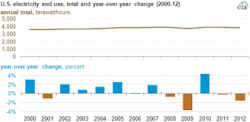US Electricity Sales Drop: Is it the Economy or Energy Efficiency?
For decades the US used more and more electricity. Then growth flat lined a few years ago. What caused the slowdown? Many credited (or blamed depending on your perspective) the economic collapse.
But now, an analysis by American Council for an Energy-Efficient Economy indicates that in fact energy efficiency has played the bigger role.
Energy efficiency and mild weather seem to be the primary cause of the 1.9 percent drop in electricity sales from 2007-2012, according to “Why is Electricity Use No Longer Growing?” a white paper by ACEEE’s Steven Nadel, executive director and Rachel Young, national policy research analyst.
Over that time period the US saw a significant ramp up in equipment efficiency standards and utility energy efficiency programs. Those programs had a statistically significant impact on residential and commercial energy use, although not industrial consumption, according to the white paper.
Source: US Energy Information Administration
Nadel and Young said that their findings echoed last year’s study by The CO2 Scorecard Group that attributed 75 percent of the emissions decline in 2012 to reduced energy demand, mostly from energy efficiency, but aided by a mild winter.
Other interesting data from the ACEEE white paper:
- Electricity sales peaked in 2007, declined in 2008 and 2009 (the recession), increased in 2010, then dropped again in 2011 and 2012.
- Retail electric sales were down 0.7 percent for the first 10 months of 2013 compared with the first 10 months of 2012.
- Electricity use declined per capita 1.21 percent annually from 2007-2012 while population grew 0.92 percent on average over the same period.
- Manufacturing GDP increased by 14.5 percent from 2010-2012, while industrial electricity use increased by 1.5 percent. This could be a result of increased production from efficient factories and decreased production from inefficient factories coming out of the recession, according to ACEEE.
- Distributed generation has been growing, but has really picked up recently. Nearly half the increase over the five-year period measured happened in the last year, 2012.
The white paper is available here and a blog by Nadel on the findings is here.
How do you think these findings might influence energy efficiency policy? Are they likely to ignite or calm the anti-energy efficiency push in Indiana and Ohio? Let us know your thoughts on the Energy Efficiency Markets LinkedIn Group.
About the Author
Elisa Wood
Editor-in-Chief
Elisa Wood is the editor and founder of EnergyChangemakers.com. She is co-founder and former editor of Microgrid Knowledge.
